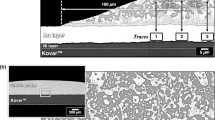Abstract
The interfacial reactions between eutectic PbSn solder and the solder ball pads with the Au/Ni surface finish were studied. Solder joints subjected to up to three repeated reflow-and-aging treatments were examined. For the reflow, the peak reflow temperature was 225°C, and the reflow time was 115 s. Each aging process was performed at 160°C for 500 h. After the first reflow, all the Au would disappear from the interface, and formed many (AuxNi1−x)Sn4 particles inside the solder joints. The value of x was between 0.99 and 0.75. In addition, there was a thin layer of Ni3Sn4 (1.4 µm) at the interface. After one reflow and one subsequent aging, most of the (AuxNi1−x)Sn4 would relocate from inside the solder joint to the interface, and the value of x for (AuxNi1−x)Sn4 at the interface decreased to 0.45. This (AuxNi1−x)Sn4 resettlement process repeated itself for additional reflow-aging cycles. More reflow-aging treatments, however, made the microstructure of (Au0.45Ni0.55)Sn4 at the interface become more non-planar. It was shown that gravitational effect was not the driving force for the resettlement of (AuxNi1−x)Sn4. It is proposed that the driving force is for (AuxNi1−x)Sn4 to seek Ni at the interface so that it can become more Ni-rich. In other words, the driving force is lowering the Gibbs energy of (AuxNi1−x)Sn4 by dissolving more Ni. A decomposition-diffusion mechanism is proposed to explain what happened. Kinetic rationales for this rapid resettlement of (AuxNi1−x)Sn4 at such a low temperature were also discussed.
Similar content being viewed by others
References
E. Bradley and K. Banerji, IEEE Trans. Comp. Pkg. and Mfg. Technol. B 19, 320 (1996).
K. Banerji and R.F. Darveaux, Microstructures and Mechanical Properties of Aging Materials, ed., P.K. Liaw, R. Viswanathan, K.L. Murty, E.P. Simonen, and D. Frear (Warrendale, PA: TMS, 1993), p.431.
R. Darveaux, K. Banerji, A. Mawer, and G. Dody, Ball Grid Array Technology, ed. J.K. Lau (New York, McGraw-Hill, 1995), p.379.
Z. Mei, M. Kaufmann, A. Eslambolchi, and P. Johnson, 1998 Electron. Comp. Tech. Conf. Proc. 952 (1998).
C.E. Ho, Y.M. Chen, and C.R. Kao, J. Electron. Mater. 28, 1231 (1999).
P.G. Kim and K.N. Tu, Mater. Chem. and Phys. 53, 165 (1998).
P.G. Kim and K.N. Tu, J. Appl. Phys. 80, 3822 (1996).
S. Anhöck, H. Oppermann, C. Kallmayer, R. Aschenbrenner, L. Thomas, and H. Reichl, 1998 IEEE/CPMT Berlin Intl Manufacturing Tech. Symp. Proc., 156 (1998).
H. Baker, ed., ASM Handbook Vol. 3: Alloy Phase Diagrams (Materials Park, OH: ASM, 1992).
W.K. Warburton and D. Turnbull, Diffusion in Solids—Recent Developments, ed. A.S. Nowick and J.J. Burton (New York, Academic Press, 1975), p.171.
Author information
Authors and Affiliations
Rights and permissions
About this article
Cite this article
Ho, C.E., Zheng, R., Luo, G.L. et al. Formation and resettlement of (AuxNi1−x)Sn4 in solder joints of ball-grid-array packages with the Au/Ni surface finish. J. Electron. Mater. 29, 1175–1181 (2000). https://doi.org/10.1007/s11664-000-0010-y
Received:
Accepted:
Issue Date:
DOI: https://doi.org/10.1007/s11664-000-0010-y




